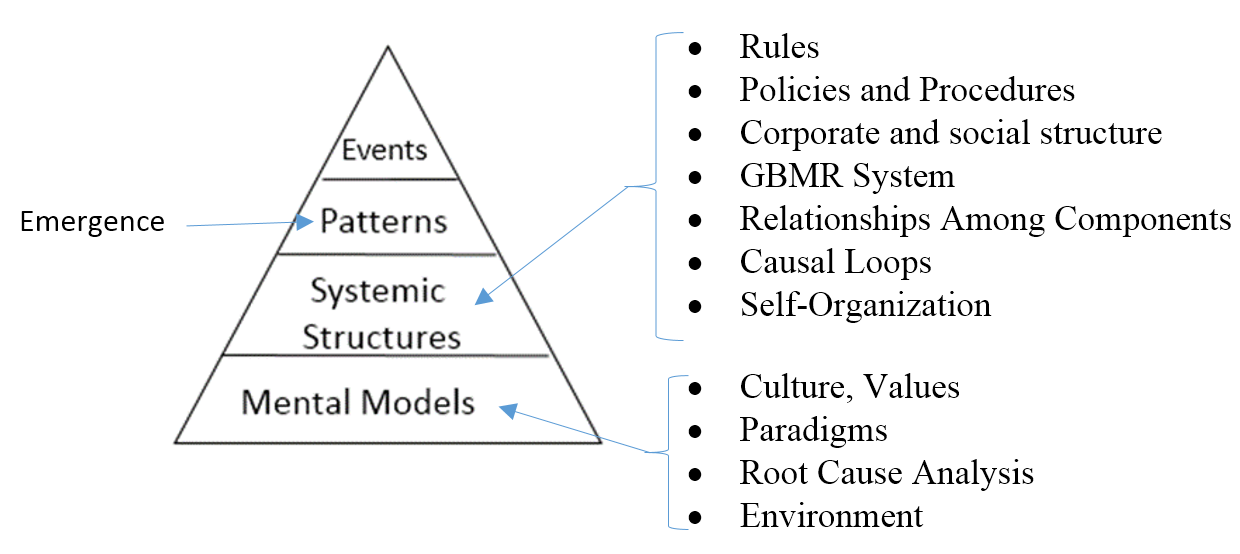-
Paper Information
- Paper Submission
-
Journal Information
- About This Journal
- Editorial Board
- Current Issue
- Archive
- Author Guidelines
- Contact Us
American Journal of Systems Science
2015; 4(2): 36-49
doi:10.5923/j.ajss.20150402.02

Using Systems Thinking to Analyze ISIS
Jamie P. Monat, Thomas F. Gannon
Systems Engineering Program, Worcester Polytechnic Institute, Worcester, MA, USA
Correspondence to: Thomas F. Gannon, Systems Engineering Program, Worcester Polytechnic Institute, Worcester, MA, USA.
| Email: |  |
Copyright © 2015 Scientific & Academic Publishing. All Rights Reserved.
This work is licensed under the Creative Commons Attribution International License (CC BY).
http://creativecommons.org/licenses/by/4.0/

Systems Thinking can be used to address complex socio-economic problems, predict behaviors, and understand the seemingly illogical actions of individuals, countries, and organizations such as ISIS. It focuses on relationships among system components as well as on the components themselves. In this paper, we apply Systems Thinking tools (including the Iceberg Model, causal loop diagrams, stock-and-flow diagrams, and dynamic modeling) to analyze ISIS’s beliefs, goals, needs, and appeal, and to suggest new strategies for dealing with ISIS. We conclude that a Systems Thinking analysis leads to approaches that are very different from typical linear thinking solutions, such as “bomb them back to the Stone Age,” and suggest alternative approaches for dealing with ISIS. These include waging a non-military but a socio-economic war against ISIS using social media, moving away from a policy of forcibly imposing democracies, rethinking the U. S.’s role as the world’s policeman, destroying ISIS’s sources of revenue, encouraging ISIS’s Middle Eastern neighbors to fight the land war (with the U. S. serving only in an advisory capacity), addressing the root causes of ISIS’s appeal, and preventing both Iran and ISIS from developing nuclear capabilities at all costs.
Keywords: Systems Thinking
Cite this paper: Jamie P. Monat, Thomas F. Gannon, Using Systems Thinking to Analyze ISIS, American Journal of Systems Science, Vol. 4 No. 2, 2015, pp. 36-49. doi: 10.5923/j.ajss.20150402.02.
Article Outline
1. Introduction and Background
- There are various current trends in and perspectives on Systems Thinking (Anderson and Johnson, 1997; Boardman and Sauser, 2008; Kauffman, 1980; Kim, 1999; Meadows, 2008; Richmond, 2004; Senge, 1990 and 2006; Weinberg, 2001. For a more extensive literature review and summary, see Monat and Gannon, 2015). From these references we have concluded that Systems Thinking is a perspective, a language, and a set of tools that can be used to address complex socio-economic issues. Specifically, Systems Thinking is the opposite of linear thinking. It is a holistic approach to analysis that focuses on the way a system's constituent parts interrelate and how systems work over time and within the context of larger systems. Systems Thinking recognizes that repeated events or patterns are derived from systemic structures which, in turn, are derived from mental models. It recognizes that behaviors derive from structure, it focuses on relationships rather than components, and it recognizes the principles of self-organization and emergence. Specific Systems Thinking tools include systemigrams, system archetypes, main chain infrastructures, causal loops with feedback and delays, stock and flow diagrams, behavior-over-time graphs, computer modeling of system dynamics, Interpretive Structural Modeling (ISM), and systemic root cause analysis (Monat and Gannon, 2015). ISIS, the Islamic State of Iraq and Syria, is a jihadist organization of Sunni Muslims who have been gaining support and recruits in their effort to achieve world domination, killing and maiming thousands of non-believers in the process. Their behavior has seemed self-destructive and illogical inasmuch as many of their actions have united their Middle Eastern neighbors (and in fact, much of the world) against them. Several experts and political scholars have attempted to analyze ISIS. Princeton alumnus William McCants directs the Project on U.S. Relations with the Islamic World at the Brookings Institution, teaches at Johns Hopkins University, and was a senior advisor for countering violent extremism at the U.S. Department of State. His new book, The ISIS Apocalypse: The History, Strategy, and Doomsday Vision of the Islamic State, provides a behind-the scenes look at ISIS’s history (focusing on the years 2003-2015) and motives, gleaned from private e-mails, text messages, and communiques among ISIS leaders, followers, and opponents.Shadi Hamid is a Senior Fellow in the Center for Middle East Policy at the Brookings Institute and expert on U. S. Relations with the Islamic World. In his article “Is There a method to ISIS’s Madness,” Hamid explores ISIS’s rationality as well as that of the West. He discusses the Caliphate’s need to hold and expand territory, and speculates on future ISIS behavior as they lose both territory and morale. He also speculates on the reasons that ISIS’s enemies have thus far failed to unite and on ISIS’s possible objectives.Loren Thompson’s article “Five Reasons the ISIS Fight Isn’t About Islam” draws clear distinctions between ISIS and Islam. In it, he explains how ISIS is fundamentally different from other jihadi groups and discusses the appeal of ISIS to young, disenfranchised men. Dr. Thompson is Chief Operating Officer of the Lexington Institute and was Deputy Director of the Security Studies Program at Georgetown University; he has taught both at Georgetown and at Harvard’s Kennedy School of Government. David Von Drehle, correspondent for Time magazine, wrote “The War on ISIS” in March of 2015. For this article, Von Drehle interviewed ISIS sympathizer Anjem Choujary, Deputy National Security Advisor Ben Rhodes, Aron Lund (editor of “Syria in Crisis” for the Carnegie Endowment for International Peace), and Fawaz Gerges, Emirates Chair in Contemporary Middle East Studies at London’s School of Economics. The article describes some of the pitfalls associated with imposing democracy, as well as how the U. S. may have contributed to the rise of ISIS.One of the best analyses was conducted by Graeme Wood and published in The Atlantic in March of 2015. For his article, Wood interviewed Princeton scholar Bernard Haykel, a leading expert on ISIS; Peter R. Neumann, Director of the International Centre for the Study of Radicalisation and Political Violence and professor of Security Studies at King’s College, London; Australian Musa Cerantonio, widely regarded as one of the most important ISIS spiritual authorities; Londoners Anjem Choudary, Abu Baraa, and Abdul Muhid, all former members of the banned Islamist group “Al Muhajiroun,” and Salafi imam Breton Pocius from Philadelphia. Based on these interviews, Wood was able to develop a fairly clear picture of ISIS’s motives and objectives.In the sections of this paper that follow, we have attempted to synthesize the views of these political experts and use them together with Systems Thinking to understand ISIS’s seemingly illogical behavior and, in fact, to address the issue. To analyze this situation, it is helpful to summarize ISIS’s beliefs, goals, needs, and appeal, as articulated by these political experts.ISIS Beliefs. ISIS believes that the Koran is a manual for war and that it must be followed literally. Slavery, crucifixion, beheadings, stonings, amputation, and rape of infidel women are all mandated by the Koran. ISIS further believes that infidels must be treated without mercy (an infidel is anyone who does not follow the Koran literally). But there are different kinds of infidels: pagans (such as Christians and Jews) must be enslaved; but the worst kind of infidels are apostate Muslims, who must be put to death. Included in this category are Al-Qaeda and all Shia. ISIS also believes that democracy, elections, national borders, alcohol, drugs, and enforcing any law not made by God are immoral and excommunicable; and that it is apostate to recognize any authority other than God. Interestingly, ISIS’s principal enemies are apostate Muslims, not Christians, Jews, or the U.S.; but ISIS does believe that the U.S. wants to eradicate Muslims.ISIS declared a Caliphate on June 29th, 2014, designating Abu Bakr al-Baghdadi as its Caliph. This is the first Caliphate declared in the Muslim world in over 1,000 years. ISIS believes that the Caliphate is a vehicle for salvation. To go to paradise, a Muslim must pledge allegiance to the Caliph. There will be only 12 legitimate Caliphs (Baghdadi is the 8th.)ISIS believes that the path to paradise is via Jihad (Holy War), which must be waged at least once per year. Final Sunni victory will occur at a battle in Jerusalem at which the anti-Messiah (from Iran) will kill all except 5,000 of the faithful, who will be rescued at the last minute by (interestingly) Jesus. Prior to this final showdown, there will be a period of Islamic conquest led by the Mahdi, a messianic figure destined to lead the Muslims to victory before the end of the world. The period of Islamic conquest will be initiated by a victory at Dabiq, in northern Syria, where the armies of Rome will meet the armies of Islam. ISIS has already stationed people at Dabiq and want to wage the Battle of Dabiq as soon as possible.ISIS Goals. The ultimate goal of ISIS is world domination leading to the end of days, at which time the most faithful will ascend to paradise. But there are several sub-goals required to achieve this endgame. The first is a Caliphate with Abu Bakr al-Baghdadi as Caliph (a “Caliphate” is an Islamic state; a form of Islamic government led by a Caliph who is a political and religious leader and a successor (Caliph) to the Islamic prophet Mohammed. His power and authority are absolute.) Baghdadi is the first declared Caliph in more than 1,000 years. Before the apocalypse, ISIS wants to return civilization to a 7th century legal environment with no borders, after forcible expansion into non-Muslim countries, and to purify the world by killing vast numbers of people who are apostate, per Takfiri doctrine. To further this goal, ISIS does not enter into long-lasting (meaning >10 years) peace treaties. Another ISIS goal is free housing, food, clothing, and health care for all, which may explain its appeal to Sunni Muslims who do not have these now. It is important to note that as ISIS’s territory and populace expand, its need for resources to support this goal will expand dramatically. Finally, to hasten the end of times, ISIS wants to draw the U. S. into a war and accelerate the battle of Dabiq, which represents the start of the countdown to the apocalypse. ISIS’s outrageous acts of beheadings, immolations, and other atrocities are designed to terrorize its enemies into either capitulation or outright war and thus serve this goal.ISIS Needs. To achieve its goals, ISIS needs a Caliph (and 4 more after Baghdadi), territory it controls, and a continual expansion of territory it controls. This need to take and hold territory is a vulnerability. (From the map in Figure 1, it seems clear that ISIS is pushing outward in a ring centered west of Kirkuk. With only 30,000 soldiers, as this perimeter grows, the resources required to retain and control the center of the ring will stretch thin. This represents a vulnerability and an opportunity for ISIS’s enemies to infiltrate and fight ISIS from within its own perimeter.) ISIS also needs money and resources for food, clothing, healthcare, weapons, and ammunition in an ever-growing geography and populace. It also needs continuous victories and growth to maintain internal support and an influx of new recruits (another vulnerability). ISIS functions on a strong command/control management structure in which the Caliph holds ultimate power and authority. Finally, ISIS needs victory at Dabiq and Jesus Christ, who is prophesied to be the savior of the Islam faithful at Jerusalem at the time of the apocalypse.
 | Figure 1. ISIS Territories as of December 2014 (Map developed by the Institute for the Study of War and published in The Atlantic, March 2015) |
2. Systems Thinking Analysis
- A Systems Thinking Approach to Warfare: In Blink, Malcolm Gladwell says, “Conflict in the future would be diffuse. It would take place in cities as often as on battlefields, be fueled by ideas as much as by weapons, and engage cultures and economies as much as armies.” As one US Joint Forces Command (JFCOM) analyst puts it: “The next war is not going to be military on military. The deciding factor is not going to be how many tanks you kill, how many ships you sink, and how many planes you shoot down. The decisive factor is how you take apart your adversary’s system. Instead of going after war-fighting capability, we have to go after war-making capability. The military is connected to the economic system, which is connected to their cultural system, to their personal relationships. We have to understand the links between all those systems.” With respect to ISIS, we should not be fighting a military war, but a socio-economic one.ISIS needs huge sums of money to fund its military and social programs. Its principal sources of income are oil (which is smuggled out of the country), wheat, taxes and extortion from its own populace, and ransom for hostages. Estimates are that ISIS is worth $2 billion and generates about $30 million/month from oil, $30 million/month from extortion/taxes, and $2 million/month from hostage ransoms (Bajekal, Bronstein). ISIS’s cultural appeal (based upon both fairness according to Allah and guaranteed food, clothing, and medical care to yield a better life) renders it susceptible to criticism and disillusionment if those promises are not fulfilled, and if the populace grows to resent the extortion and increased tax rates. As oil production infrastructure has been targeted, ISIS has relied more upon taxes and extortion to fund its coffers.
3. Iceberg Models
- The Iceberg Model (Kim, 1999; Meadows, 2008; Anderson and Johnson, 1997; Senge et al., 1994) is an excellent systems thinking tool. It is useful for understanding how mental models give rise to systemic structures which, in turn, yield patterns of events. The events and patterns are visible to us, but the mental models and structures are often hidden and must be discovered.Table 1 below lists some relevant mental models and the structures, patterns, and events that result based on our analysis of ISIS’s beliefs, goals, needs, and appeal. Each row in the table represents a different Iceberg Model.
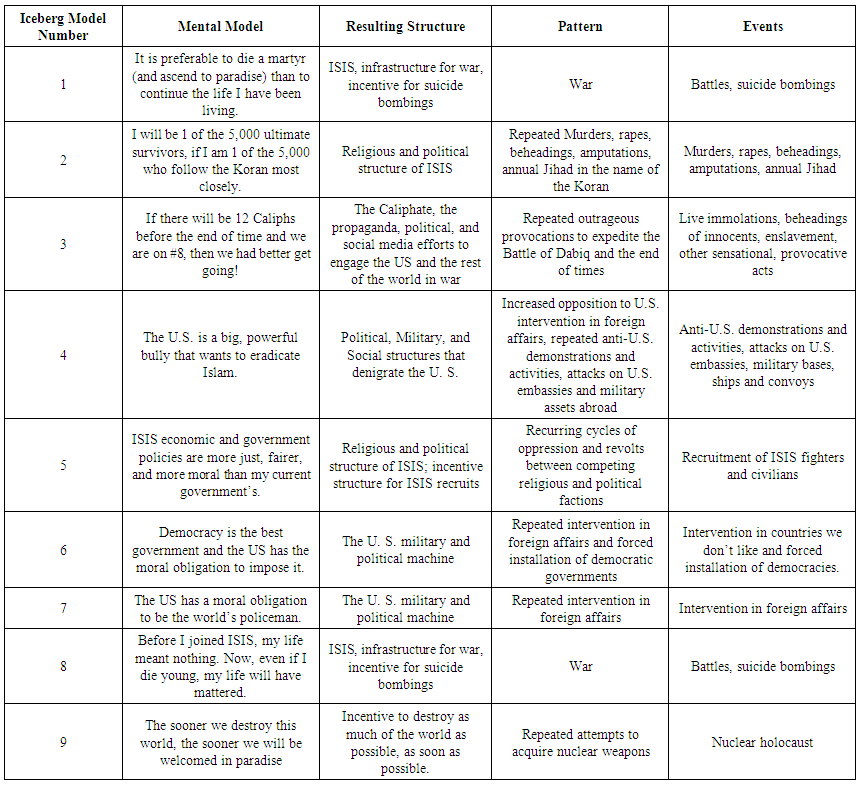 | Table 1. Iceberg Models Relevant to ISIS |
4. ISIS vs Iran: 2 Warring Caliphates
- ISIS (Sunni) and Iran (Shiite) may have similar goals. One significant difference is that ISIS has already declared a Caliphate while Iran has not. However, Iran’s refusal to commit to long-term treaties; steadily increasing influence over western Afghanistan, Iraq, Syria, Lebanon, and Yemen; and recent calls for a “global Caliphate” suggest similar thinking. Indeed, according to Shillman Fellow in Journalism Daniel Greenfield, “Iran views its struggle with the US as a gateway to the apocalypse, the Islamic end of days and the mass murder of non-Muslims.” The greatest threat to the world would be a Caliphate with nuclear capability, which would transpire if Iran wins the war against ISIS and develops a nuclear bomb. This implies that the defeat of ISIS is an immense threat and that it is to the world’s advantage to let ISIS continue to keep Iran in check. It also suggests that Iran must be kept from developing nuclear capabilities at all costs. (ISIS may also be attempting to acquire weapons-grade uranium.)
5. Causal Loop Diagrams
- Causal loop diagrams (CLDs) show cause-and-effect relationships among system components (Anderson and Johnson, 1997; Goodman et al.; Kauffman, 1980; Richmond, 2004). They are especially useful for understanding the role of feedback, which is very often present (and under-appreciated) in systems. There is a famous causal loop diagram that was developed by the PA Consulting Group describing the war in Afghanistan, shown below in Figure 3.
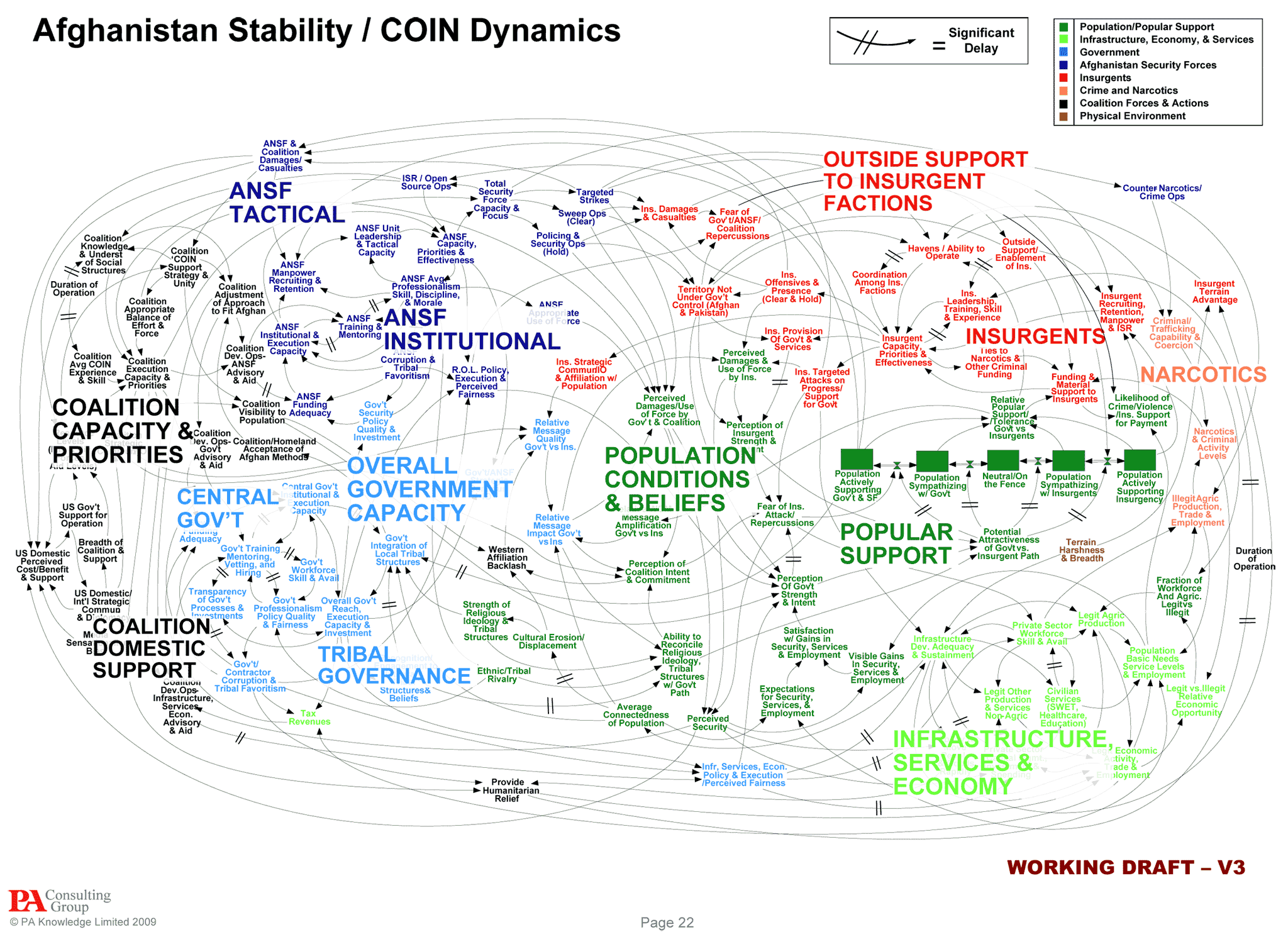 | Figure 3. CLD Model of the War in Afghanistan |
 | Figure 4. The U.S. as World Policeman |
 | Figure 5. The Addiction Archetype |
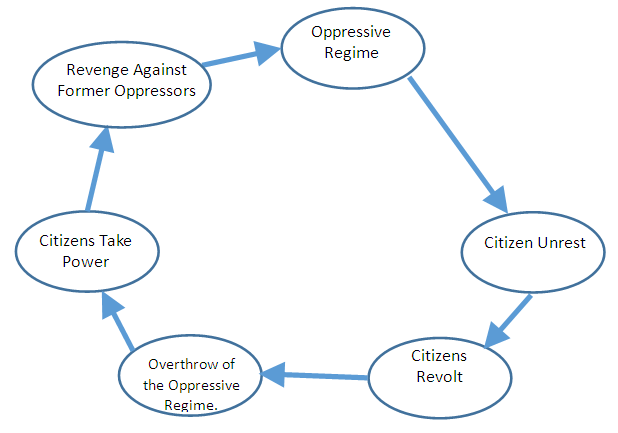 | Figure 6. The Recurring Cycle of Arab Oppression |
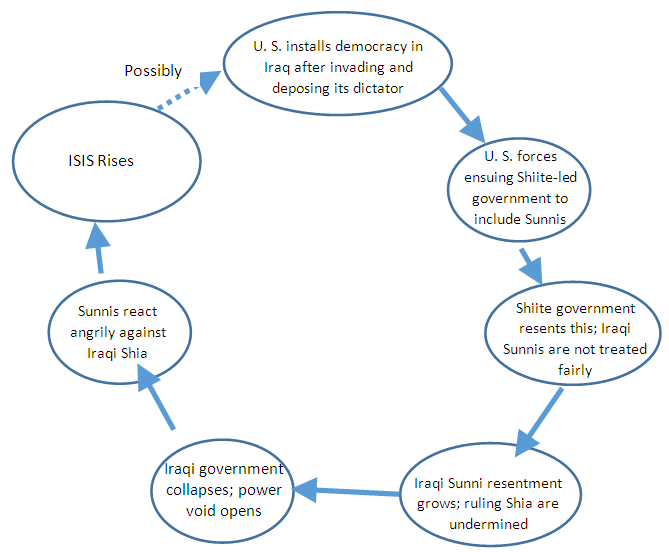 | Figure 7. The Rise of ISIS |
6. Stock-and-Flow Diagrams
- A simplified stock-and-flow diagram (Bellinger, 2004; Kim, 1999; Meadows, 2008; Richmond, 2004) may be used to model the amount of resources and revenues ($$) needed as ISIS-controlled territory and population grow. The diagram below was created using iThink dynamic modeling software from isee Systems, Inc., Lebanon, NH (model details are available from the authors). Territory Gain Rate, Revenues ($$) from Oil, and Per Person Costs of Food, Clothing, and Healthcare were set as independent variables in this model.The following three figures are output graphs from the dynamic simulation, and illustrate a dramatic increase in expenses, a decrease in ISIS’s cash reserves, and a dramatic decrease in popular support as ISIS gains territory and soldiers.The model reveals that funding; rate of population gain via acquired territory; and food, clothing, and healthcare costs per person are key leverage points of the system. If the ISIS-controlled population increases faster than its revenues, then either ISIS’s cash reserves or the services it provides to its people (or both) will decrease, resulting in loss of support. It is clear that destruction of ISIS’s oil, wheat, and financial infrastructure while increasing the costs of food, clothing, and healthcare are keys to unravelling ISIS’s popularity and support. (One should be cautioned to not use these unvalidated dynamic simulations as definitive quantitative solutions, but only to elucidate cause-and-effect relationships, leverage points, and potential dynamic behaviors over time.)Many similar simulations are possible using the iThink software.
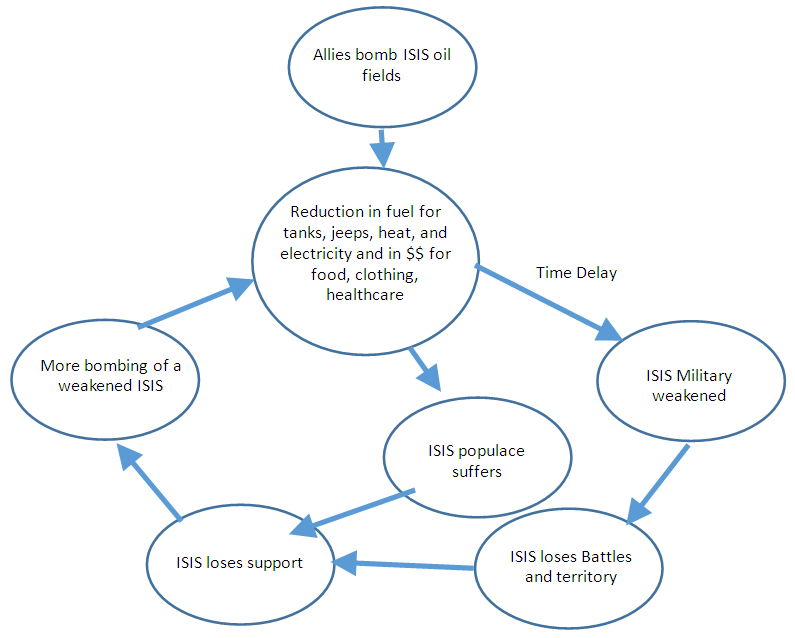 | Figure 8. The Destruction of ISIS Infrastructure |
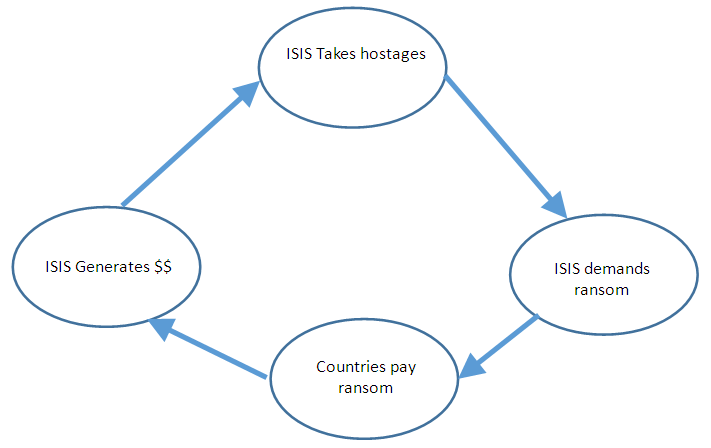 | Figure 9. ISIS Revenue from Hostage Ransom |
 | Figure 10. Dynamic Simulation Model of ISIS Revenue, Resources, Cash Reserves and Popular Support |
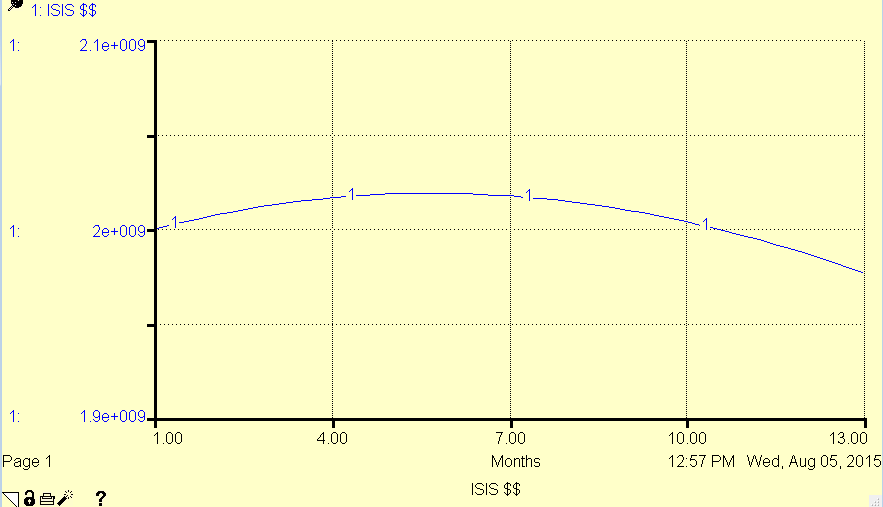 | Figure 11. ISIS Cash Reserves versus Time |
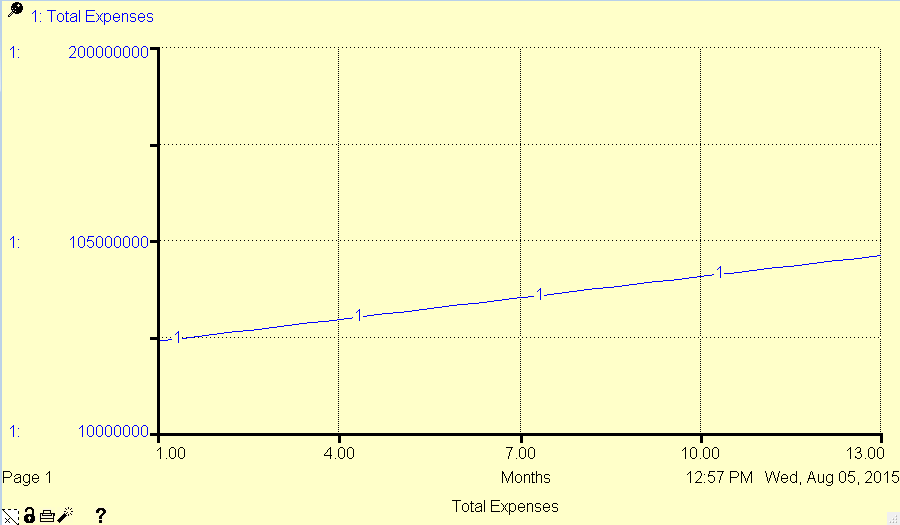 | Figure 12. ISIS Expenses versus Time |
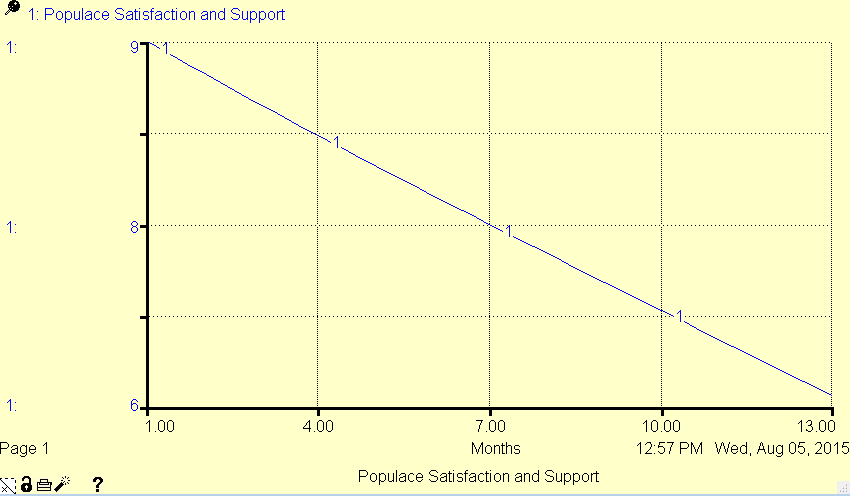 | Figure 13. ISIS Popular Satisfaction and Support versus Time |
7. Discussion
- Linear thinking often leads to unintended consequences and short-term solutions to problems which then recur. This has certainly been the case with America’s foreign policy in the Middle East. Systems Thinking has a much greater probability of uncovering the root causes of issues and implementing real solutions.One linear thinking approach to ISIS is to bomb them back to the Stone Age (Texas GOP Senator Ted Cruz, Kevin Fobbs in ClashDaily, Tom Dougherty in Practical Politicking, and many others). The idea of fighting a military war against this enemy is unlikely to succeed strategically. Even if we succeed in decimating ISIS, the root causes of ISIS-type movements remain. These include corrupt, nepotistic Middle Eastern governments, extensive poverty, an archaic social system in which it is impossible for the disadvantaged to succeed, and disillusioned youth. Eliminating ISIS without addressing the underlying causes will just result in a new ISIS by a different name. Systems Thinking, on the other hand, addresses this issue by examining the underlying causes of ISIS and its appeal. The Systems Thinking solution is to fight not a military war, but a socio-economic one powered by social media.A second linear thinking concept is that democracy is the best form of government. While this is true in many cases, it is not universally applicable. First of all, the United States does not enjoy a pure democracy, but a constitutional democracy in which the people believe in the constitution and the legal system upholds it. In a pure democracy, majority rules and it would be easy for the majority to deny rights to all minorities. Our constitution and Bill of Rights prevent this. The concept that minorities enjoy the same rights as the majority is not understood by many Middle Easterners who view democracy as an opportunity to take control. Secondly, a democratic government works when the people believe in it as the highest law in the land. In a region where religious doctrine trumps secular law, democracy may not succeed. Third, one cannot impose democracy without examining the history of the region. In Iraq, where the majority Shia were repressed for decades by the ruling Bath party, the sudden change to democracy presented an opportunity for revenge. Systems Thinking examines these ramifications and potential unintended consequences, and concludes that democracy may not be the best form of government, particularly if it is imposed.A third linear thinking attitude is that the United States has a right and moral obligation to be the world’s policeman. It is clear from our analysis that the use of the “U. S. as World Policemen” mental model will only continue to cause resentment from other countries, increase opposition to U.S. efforts abroad, give rise to support for anti - U.S. activities, and prevent other counties from fighting their own battles. Systems Thinking suggests that the U. S. should encourage ISIS’s Middle Eastern neighbors to work together and coordinate efforts to attack and defeat ISIS, with U. S. assistance as advisors and with air support only if requested.It seems clear that Systems Thinking would yield vastly different approaches to geo-political problems than has linear thinking.There are different definitions of Systems Thinking (see Monat and Gannon, 2015). Some systems thinking experts believe that systems thinking includes system dynamics modeling, causal loop analysis, and stock-and-flow diagrams, but excludes the Iceberg Model and the patterns and events caused by systemic structures and mental models. One can see from Table 1 above that the inclusion of the Iceberg Model and, specifically, the systemic structures and causative mental models, yield a much richer picture of the systemic behavior patterns of ISIS, the U.S., and other countries.
8. Conclusions
- We have applied a comprehensive set of Systems Thinking tools (including the Iceberg Model, causal loop diagrams, stock-and-flow diagrams, and dynamic modeling) to analyze ISIS’s beliefs, goals, needs, and appeal, and to suggest new strategies for dealing with ISIS. Based on our Iceberg Model analysis, we have also identified numerous mental models and systemic structures that help explain the actions taken by ISIS, the U. S., and other countries. The following summarize the results of our analyses and the conclusions we have reached using a Systems Thinking approach. Conclusion 1: The appeal of ISIS is not based upon high-level religious and spiritual ideals, but on basic human needs as articulated by Maslow. The benefits of the individual System Thinking tools (such as the Iceberg Model) seem clear; however the real power of Systems Thinking becomes apparent when those tools are coupled. By integrating Iceberg Models 1, 5, and 8 from Table 1, one may infer that people join ISIS not out of religious principle but out of the promise of a fairer life with more opportunity in which food, clothing, housing, and medical care are assured. Defeating ISIS will require demonstration that this promise cannot be fulfilled by ISIS and that other approaches will fulfill it. The U. S. and its Middle Eastern allies have many more financial resources than does ISIS. If ISIS soldiers are acting on the survival level of Maslow’s hierarchy rather than on some high spiritual-imperative level (as some undoubtedly are), then we should offer ISIS soldiers $500/month to fight against their ISIS leaders. This approach worked well for some fighters during the Iraq war. Note that $500/month for 30,000 soldiers comes to just $180,000,000/year, a tiny fraction of our military or foreign affairs budgets. A propaganda campaign targeting ISIS soldiers (and involving social media) should be developed to support this campaign.Conclusion 2: The fight against ISIS should not be a military war but a socio-economic one fueled by social media. This conclusion is justified by Iceberg Models 1, 8, and 9 from Table 1 in conjunction with the system dynamics model depicted in Figures 10-13. The need for exponentially-increasing resources and revenues will be ISIS’s undoing; as they cannot continue to provide for the growing number of their people, their people will become disillusioned and defect. The world can accelerate this by denying access to the resources ISIS needs to sustain its populace. Therefore, we should invest time in tracing ISIS’s revenue streams and attacking ISIS’s infrastructure, such as oil, wheat, ransom for hostages, and taxation/extortion. If ISIS cannot provide food, clothing, healthcare, and a better life for their people, they will lose support. As time moves on, providing these will become harder and harder for ISIS, and they will eventually burn out. It is therefore important to demonstrate that under ISIS, civilian life is NOT better. We should let ISIS grow to control more and more people while continually cutting off their oil, wheat, and ransom revenues; isolate them financially. Allow ISIS to respond by routinely increasing its tax and extortion rates, which will stress their populace and undermine their claim to fairness. Patience and perseverance are essential here. Social media should be used as a weapon against ISIS. Highly respected Sunni muftis should openly challenge ISIS’s interpretation of the Koran. A propaganda campaign should demonstrate that life under ISIS is not the path to paradise that is was touted to be and should underscore the suffering of the people under ISIS’s control. Individuals should be encouraged to defect and come back to the true Sunni religion: the one that will get them to paradise while enjoying life in this world.Conclusion 3: The U. S. policy in the Middle East must change from forcibly installing democracies to one of an appreciation for the region’s culture, history, and politics and one of incenting and rewarding Middle Eastern countries to become less corrupt, less coercive, more accountable, and less based on nepotism and hereditary power. Democracy may not be the best form of government, especially when it is imposed. The problem will not go away until the local Middle Eastern governments become less corrupt, less coercive, and more accountable. Until then, the growing number of unemployed youth in Arab countries will find ISIS and similar concepts attractive because they are more fair, just, and moral, and offer more hope for a good life. Historically, imposing democracy has not addressed this issue. Bombing ISIS back to the Stone Age will not solve these problems, and as soon as another cause rises with credible relief on these points, a new ISIS will arise with a different name. These conclusions are based upon Iceberg Model 6 from Table 1 coupled with the causal loop diagrams of Figures 6 and 7.Conclusion 4: The U. S. Should Stop Acting as the World’s Policeman. If one couples Iceberg Models 4, 6, and 7 from Table 1 with the causal loop diagrams depicted in Figures 4, 5, and 7, one may conclude that “The U. S. as World Policeman” feedback loop reinforces the resentment of other countries to U. S. interventions in local conflicts. This policy also leads to the devaluation of freedom and democracy because other countries don’t need to fight battles and secure freedom on their own; freedom is devalued when it is simply handed to a populace and not earned. Systems Thinking suggests that instead of fighting ISIS directly, the U. S. should encourage ISIS’s Middle Eastern neighbors to coordinate their efforts to defeat ISIS, with U. S. advice and air support only if requested.Conclusion 5: The greatest threat to world peace is the evolution of Iran as a nuclear Caliphate. The causal loop diagrams depicted in Figures 6 and 7 suggest that the recurring cycle of oppression among competing Middle East regimes coupled with U. S. intervention in Iraq contributed to the rise of ISIS as an unintended consequence. The military defeat of ISIS (linear thinking) could also give rise to another unintended consequence, namely the emergence of Iran as another Caliphate with nuclear capability. We know that Iran is pursuing nuclear capabilities; it would not surprise us if ISIS were also seeking weapons-grade uranium. As we postulated earlier, the defeat of ISIS could be an immense threat to the world, and it may be more advantageous to let ISIS continue to keep Iran in check.
Note
- 1. Raqqa’s Credit Bank is reputed to be the depository and tax authority for much of ISIS’s funds (Hubbard, 2014).
 Abstract
Abstract Reference
Reference Full-Text PDF
Full-Text PDF Full-text HTML
Full-text HTML